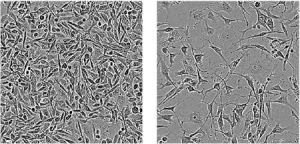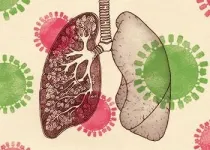(Press-News.org) In cancer research, it's a common goal to find something about cancer cells -- some sort of molecule -- that drives their ability to survive, and determine if that molecule could be inhibited with a drug, halting tumor growth. Even better: The molecule isn't present in healthy cells, so they remain untouched by the new therapy.
Plenty of progress has been made in this approach, known as molecular targeted cancer therapy. Some current cancer therapeutics inhibit enzymes that become overactive, allowing cells to proliferate, spread and survive beyond their norm. The challenge is that many known cancer-driving molecules are "undruggable," meaning their type, shape or location prohibit drugs from binding to them.
University of California San Diego School of Medicine researchers are now exploring the therapeutic potential of RNA-binding proteins, a relatively untapped family of cancer-driving molecules. After genes (DNA) are transcribed into RNA, these proteins provide an extra layer of cellular control, determining which RNA copies get translated into other proteins and which don't. Like many molecular systems that govern cell growth, RNA-binding proteins can contribute to tumor development when they malfunction.
In their latest study, publishing July 2, 2021 in Molecular Cell, the UC San Diego School of Medicine team discovered in human cells and mouse models that RNA-binding proteins represent a new class of drug targets for cancers, including triple-negative breast cancer, a particularly difficult-to-treat cancer because it lacks most other molecular drug targets.
One RNA-binding protein in particular stood out: YTHDF2. When the researchers genetically removed YTHDF2 from human triple-negative breast tumors transplanted into mice, the tumors shrank approximately 10-fold in volume.
"We're excited that RNA-binding proteins look like they could be new class of drug targets for cancer," said senior author Gene Yeo, PhD, professor of cellular and molecular medicine at UC San Diego School of Medicine. "We're not yet sure how easily druggable they are in this context, but we've built a solid framework to begin exploring them."
Yeo led the study with Jaclyn Einstein, PhD, a graduate student in his lab. Einstein will join a startup company spun out from the lab to explore YTHDF2's druggability.
Yeo's team has long studied the role of RNA-binding proteins in a number of other diseases. In 2016, for example, they discovered that mutations in one such protein contribute to ALS by scrambling crucial cellular messaging systems.
To begin exploring RNA-binding proteins as cancer drug targets, the researchers turned to an old philosophy known as synthetic lethality. In this one-two punch approach, they started with human breast cells engineered to over-produce another well-known cancer-driving molecule, and looked for additional vulnerabilities specific to those cells.
The researchers systematically silenced RNA-binding proteins in these cancer cells one-by-one using the CRISPR gene editing technique. They found 57 RNA-binding proteins that, when inhibited, kill cancer cells with the known hyperactive cancer-driver. The advantage of the synthetic lethal approach is that normal cells, which don't produce that cancer-driving molecule, should be left untouched by the treatment. Of these 57 RNA-binding proteins, YTHDF2 appeared most promising.
Yeo's team also recently developed a new laboratory technique called Surveying Targets by APOBEC-Mediated Profiling (STAMP), which allows them to measure what had previously been largely invisible: how RNA-binding proteins interact with RNA molecules within individual cells.
The researchers used STAMP in this study to get a detailed look at how the various cells that make up a breast tumor behave without YTHDF2. The approach revealed that YTHDF2-deficient cancer cells die by stress-induced apoptosis, a carefully controlled mechanism cells use to destroy themselves. Apoptosis is supposed to shut down malfunctioning cells so tumors don't arise, but it doesn't always work. By removing YTHDF2, they managed to re-activate this cell death signal.
To test how safe it might be to treat cancer by inhibiting YTHDF2, the researchers engineered mice that lack YTHDF2 in every cell of the adult body, not just transplanted breast cancer cells. The mice appeared completely normal -- not only did they not have tumors, there were no changes in body weight or behavior.
"Those otherwise healthy mice tell us that we might expect minimal adverse side effects of potential therapies that work by targeting YTHDF2," Einstein said.
INFORMATION:
Co-authors of the study also include: Mark Perelis, Isaac A. Chaim, Julia K. Nussbacher, Alexandra T. Tankka, Brian A. Yee, Assael A. Madrigal, Archana Shankar, all at UC San Diego; Jitendra K. Meena, Heyuan Li, Nicholas J. Neill, Siddhartha Tyagi, Thomas F. Westbrook, all at Baylor College of Medicine.
Disclosure: Gene Yeo and Jaclyn Einstein are inventors on a patent disclosure at UC San Diego related to this work. Yeo is co-founder, member of the Board of Directors, equity holder, on the Scientific Advisory Board and paid consultant for Locanabio and Eclipse BioInnovations. Yeo is a visiting faculty at the National University of Singapore. The terms of these arrangements have been reviewed and approved by the University of California San Diego in accordance with its conflict-of-interest policies.
What The Study Did: Researchers in this study aimed to determine how each state and the District of Columbia planned to ensure equitable COVID-19 vaccine distribution.
Authors: Juan C. Rojas, M.D., of the University of Chicago, is the corresponding author.
To access the embargoed study: Visit our For The Media website at this link https://media.jamanetwork.com/
(doi:10.1001/jamanetworkopen.2021.15653)
Editor's Note: The article includes conflict of interest and funding/support disclosures. Please see the article for additional information, including other authors, author contributions and affiliations, conflict of interest and financial ...
What The Study Did: Changes in the use of women's preventive health services during the COVID-19 pandemic, including screening for sexually transmitted infections, breast and cervical cancer, and obtaining contraceptives from pharmacies are described by researchers in this study.
Authors: Nora V. Becker, M.D., Ph.D., of the University of Michigan Medical School in Ann Arbor, is the corresponding author.
To access the embargoed study: Visit our For The Media website at this link https://media.jamanetwork.com/
(doi:10.1001/jamahealthforum.2021.1408)
Editor's Note: The article includes conflict of interest disclosures. Please see the article for additional information, including other authors, ...
What The Study Did: Researchers estimated the frequency and magnitude of surprise bills for deliveries and newborn hospitalizations, which are the leading reasons for hospitalization in the United States, to illustrate the potential benefits of federal legislation that will protect families from most surprise bills. Potential surprise bills were defined as claims from out-of-network clinicians and ancillary service providers, such as an ambulance.
Authors: Kao-Ping Chua, M.D., Ph.D., of the University of Michigan Medical School in Ann Arbor, is the corresponding author.
To access the embargoed study: Visit our For The Media website at this link https://media.jamanetwork.com/
(doi:10.1001/jamahealthforum.2021.1460)
Editor's Note: The article includes conflict of ...
What The Study Did: This study investigates whether different risk factors identify the same hospitals caring for a high proportion of disadvantaged patients using seven definitions of social risk.
Authors: Susannah M. Bernheim, M.D., M.H.S., of the Yale University School of Medicine in New Haven, Connecticut, is the corresponding author.
To access the embargoed study: Visit our For The Media website at this link https://media.jamanetwork.com/
(doi:10.1001/jamahealthforum.2021.1323)
Editor's Note: The article includes conflict of interest and funding/support ...
PHILADELPHIA-- While more women are entering the field of academic medicine than ever before, they are less likely to be recognized as experts and leaders; they are less likely to receive prestigious awards, be promoted to full professorships, hold leadership roles, or author original research or commentaries in major journals. What's more, articles published by women in high-impact medical journals also have fewer citations than those written by men, especially when women are primary and senior authors, according to new research from the Perelman School of Medicine and the Leonard Davis Institute of Health Economics at the University of Pennsylvania, published today in JAMA Open Network.
Researchers found that of the 5,554 articles published in 5 leading academic medical journals ...
The Mutriku wave power plant was built on the Mutriku breakwater, a site with great wave energy potential, and has been in operation since 2011. With 14 oscillating water columns to transform wave energy, it is the only wave farm in the world that supplies electricity to the grid on a continuous basis. In general, technologies that harness the power of the waves to produce electricity are in their infancy, and this is precisely what is being explored by the UPV/EHU's Research Group EOLO, which focusses on Meteorology, Climate and Environment, among many ...
CHAPEL HILL, NC - Migraine is one of the largest causes of disability in the world. Existing treatments are often not enough to offer full relief for patients. A new study published in The BMJ demonstrates an additional option patients can use in their effort to experience fewer migraines and headaches - a change in diet.
"Our ancestors ate very different amounts and types of fats compared to our modern diets," said co-first author Daisy Zamora, PhD, assistant professor in the UNC Department of Psychiatry in the UNC School of Medicine. "Polyunsaturated fatty acids, which our bodies do not produce, have increased substantially in our diet due to the addition of oils such as corn, soybean and cottonseed to many processed foods like chips, crackers and granola."
The classes of polyunsaturated ...
According to studies in recent years, air pollution affects the thyroid. Thyroid hormones are essential for regulating foetal growth and metabolism, and play an important role in neurological development. Thyroxine (T4) is the main thyroid hormone that is circulating and the thyroid-stimulating hormone is TSH. At 48 hours newborn babies undergo a heel prick test in which thyroxine and TSH levels in the blood are measured. In fact, if the balance of these thyroid hormones is not right, the risk of developing serious diseases increases. That is why, "this study set out to analyse the relationship between atmospheric pollution during pregnancy and the level ...
When the analysis of digital data reaches its limits, methods that focus on observations made by individuals can be useful. In contexts such as the coronavirus pandemic, a method called human social sensing can elicit information that is difficult to obtain from digital trace data. Prof. Frauke Kreuter at Ludwig-Maximilians-Universitaet (LMU) in Munich is now using this method with the global "Covid Trends & Impact Survey" to predict the course of the pandemic.
Despite today's researchers in the social sciences having access to historically unparalleled amounts of data, many aspects of contemporary social developments have proven difficult to predict. National elections and the ongoing coronavirus pandemic are highly visible examples ...
The seasonal flu kills up to 600 000 people a year worldwide and has a century-long history of pandemics. Examples include the Spanish flu in the late 1910's or the H1N1 in 2009, which together claimed more than 50 million lives. "The way the stage is set tells us that it is not a matter of if but rather of when there will be a next pandemic. And preparing ourselves for that demands intensive fundamental research and constant accumulation of knowledge about these viruses and the diseases they cause", says Maria João Amorim, IGC principal investigator and leader of the team that conducted the study.
When a virus like influenza enters our lungs, it is quickly faced with cocktails of ...




